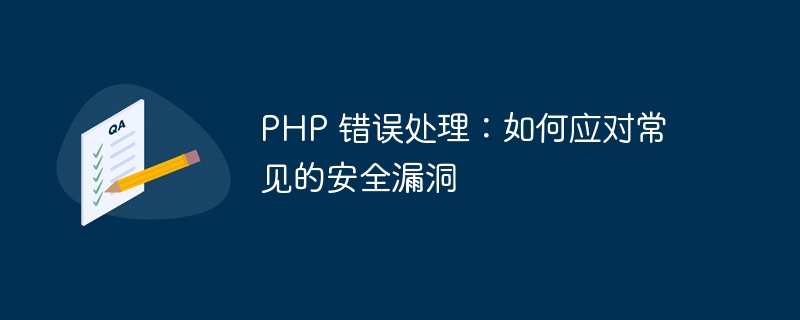Home >Backend Development >PHP Tutorial >PHP Error Handling: How to Deal with Common Security Vulnerabilities
PHP Error Handling: How to Deal with Common Security Vulnerabilities
- 王林Original
- 2023-08-09 19:03:401286browse

PHP Error Handling: How to Deal with Common Security Vulnerabilities
Introduction:
PHP is a widely used server-side scripting language for developing dynamic websites. powerful functionality and flexibility. However, due to its ease of use and flexibility, PHP also presents some security challenges. This article will introduce several common security vulnerabilities in detail and provide corresponding code examples to help developers strengthen protection and error handling against these vulnerabilities.
1. SQL injection
SQL injection is a common security vulnerability. An attacker attempts to perform unauthorized database operations by inserting malicious SQL statements into the input data. The following is a sample code that demonstrates how to use prepared statements and parameter binding to prevent SQL injection attacks.
// 从用户输入中获取用户名和密码
$username = $_POST['username'];
$password = $_POST['password'];
// 连接到数据库
$db = new PDO('mysql:host=localhost;dbname=mydb', 'username', 'password');
// 使用预处理语句和参数绑定来执行 SQL 查询
$stmt = $db->prepare('SELECT * FROM users WHERE username = :username AND password = :password');
$stmt->bindValue(':username', $username);
$stmt->bindValue(':password', $password);
$stmt->execute();
// 获取查询结果
$user = $stmt->fetch();
// 如果查询结果为空,则表示用户名或密码错误
if (!$user) {
echo "Invalid username or password.";
} else {
echo "Welcome, " . $user['username'] . "!";
} 2. XSS (cross-site scripting attack)
XSS attack is a common security vulnerability. Attackers obtain users' sensitive information by injecting malicious scripts into the content of the website. The following is a sample code that demonstrates how to use HTML special character escaping to prevent XSS attacks.
// 从用户输入中获取评论内容
$comment = $_POST['comment'];
// 对评论内容进行 HTML 特殊字符转义
$escapedComment = htmlspecialchars($comment);
// 保存评论到数据库
$db->query("INSERT INTO comments (content) VALUES ('$escapedComment')");3. File upload vulnerability
File upload vulnerability is a common security vulnerability. An attacker can execute arbitrary code on the server by uploading malicious files. Below is a sample code that demonstrates how to limit the type and size of uploaded files.
// 从上传的文件中获取相关信息
$fileName = $_FILES['file']['name'];
$fileSize = $_FILES['file']['size'];
$fileTmp = $_FILES['file']['tmp_name'];
$fileError = $_FILES['file']['error'];
// 检查文件类型和大小
$fileExt = pathinfo($fileName, PATHINFO_EXTENSION);
$allowedTypes = array('jpg', 'jpeg', 'png');
$maxSize = 1000000; // 1MB
if (!in_array($fileExt, $allowedTypes) || $fileSize > $maxSize) {
echo "Invalid file type or size.";
} else {
// 保存文件到指定目录
move_uploaded_file($fileTmp, 'uploads/' . $fileName);
echo "File uploaded successfully.";
}Conclusion:
The security of PHP is an important issue that developers need to pay attention to. By properly handling errors and strengthening protection against common security vulnerabilities, we can improve the security of our applications. When processing database operations, using prepared statements and parameter binding can effectively prevent SQL injection attacks. When displaying user input, using HTML special character escaping can effectively prevent XSS attacks. In the file upload function, limiting file types and sizes can effectively prevent malicious files from being uploaded. We should always keep security in mind and take appropriate measures to protect our applications and users’ data.
Total word count: 1455 words
The above is the detailed content of PHP Error Handling: How to Deal with Common Security Vulnerabilities. For more information, please follow other related articles on the PHP Chinese website!

